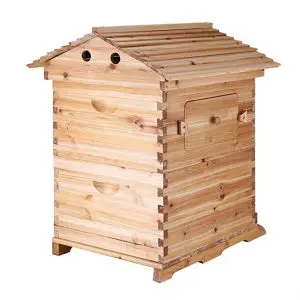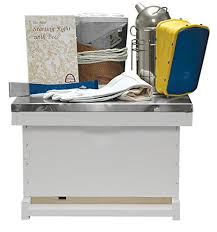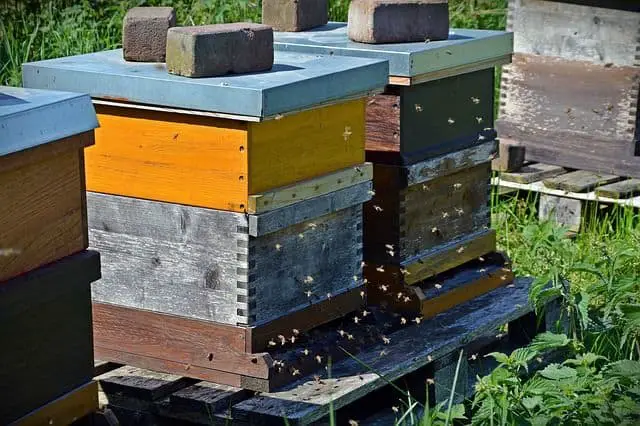Last Updated: 23 July 2024
Beekeeping is nothing more than keeping a colony of bees in a hive and harvesting the honey that they produce. Sounds simple right? Well, not really…
Honey bees are not (and cannot be) domesticated so you need to know a lot about how a colony how to start a beehive, manage it and be successful as a beekeeper. By gaining an understanding of how bees behave, you can learn to control them and they’ll produce all the honey that you want and more.
Take a look at this article for more information on how a beehive works.
However, whether you are looking to start beekeeping as a hobby, a business, or even as a combination of the two, there is a great deal that you must know before you get started.
How to Start a Beehive: Step By Step Guide
Beekeeping is a way to take an active role in agriculture and benefit from the environment at the same time.
Even people who don’t have much money or land can become beekeepers. The only people who shouldn’t get involved in beekeeping is someone who is allergic to bee stings.
Follow the steps on How to start a beehive:
- Learn the basics of beekeeping
- Find out about any local beekeeping regulations in your community.
- Inform your neighbors.
- Buy the beehive.
- But other necessary equipment.
- Pick out a location for your hive.
- You need some safety gear.
- Purchase a swarm to start the colony.
- Start your beekeeping journey
Learn the basics of beekeeping

We recommend getting hold of an in-depth beekeeping guide, one that discusses all of the aspects of beekeeping in detail. We recommend Beekeeping 101 by Discover Beekeeping, as it comes with everything you’ll need to being beekeeping and with information on the following:

Not only this, but they’ve agreed to provide our readers with some additional free bonuses, which include:
- The nutritional benefits of honey (Ebook)
- The organic gardener (Ebook)
- Honey extraction methods (Ebook)
You can find more information about the beekeeping guide here: Beekeeping 101 In-Depth Guide + Bonus Ebooks
Local Regulations
The first step you should take is to call your local council office and find out if there are any restrictions on beekeeping in your area.
Your local council office will also tell you what beekeeping organizations exist, and how you can become a member.
Local beekeeping organizations are a valuable resource for all kinds of information about beekeeping.
Inform your neighbors
To some people, bee stings can be deadly.
This is why you want to let your neighbors know that you plan to start a beehive close to them.
If anyone around you has a problem with your plans, this will be the best time to resolve it.
Buy the beehive
The first piece of equipment you will need is a good quality beehive.
There are many different types of beehives, with the most common type of beehive used in modern beekeeping is called a Langstroth hive or sometimes called a 10 frame hive.
Although the cost of beekeeping can vary, you can purchase a new Langstroth hive for approximately $300 on Amazon – We’ve recommended some below!
For the beginner beekeeper, one hive is all you need to get started with and you can by more as your hive grows.
Traditionally, beekeeping hives have always been made out of wood, however, nowadays plastic hive components are readily available.
The main benefits of using plastic hive components are that they are easy to assemble, very strong, lightweight, and require very little maintenance.
Most expert beekeepers recommend against using plastic hive covers, plastic hive bodies, and plastic bottom boards because the plastic just doesn’t breathe very well and doesn’t allow for moisture evaporation.
Beehives can be purchased unassembled or fully assembled.
The fully assembled beehive will cost a higher price and will usually have a higher shipping fee as well. A good quality supply house will always include assembly directions with unassembled bee hives, that are usually quite easy to follow.
Many experienced beekeepers will be more than happy to help you assemble your first beehive.
If you’re handy with tools, and you plan on constructing your own beehive, it is recommended that you purchase a premade hive to use as a pattern. Buying used equipment is not advisable for the beginner.
We have a range of recommended Beehives for Sale, all featured on this page. We recommend the following beehives for beginners:
Vevor Beehive with automatic honey flow – Buy on Amazon

You will also need to purchase the ‘other necessary equipment’ that we show below. However, if you’re looking for a beekeeping starter kit, which includes some of this equipment, you may want to look at the following product:
Mann Lake Beekeeper Starter Kit – Buy on Amazon

However, we highly advise that you purchase a full beekeeper suit as a beginner, believe us when we say, it hurts to get stung!
Buy other necessary equipment
Other equipment you will need is a smoker and hive tool. bee smokers are just devices that create smoke which is used to calm the bees so you can safely open the hive. While a hive tool is used to pry open frames to get honey.
Hive tools can be sharp, therefore knowing the proper use of a hive tool is important before you begin using it. Here’s a list of some useful tools that are necessary to start a beehive:
- Bee brush – Link to Recommended Amazon Product
- Hive tools – Link to Recommended Amazon Product
- Bee Smoker – Link to Recommended Amazon Product
- Queen catcher – Link to Recommended Amazon Product
- Bee Feeders – Link to Recommended Amazon Product
- Queen excluder – Link to Recommended Amazon Product
Choose a location for your hive
After you decide on which type of hive to use, the next consideration is where to place the hives. Beehives should never be placed near your home, or the homes of others, or close to areas that are used for recreation. Beehives should be placed near a pollen and nectar source, to give the bees easy access to food.
The hive should ideally be placed near a freshwater source as well, although bees can travel up to a quarter of a mile, or more for water. The front of the hive should be facing South or Southeast, with some form of windbreaker from the north and northwest.
Buy some safety gear
Another expense you will incur is a safety beekeeping gear. This may include a veil, hat, gloves and safety footwear.
These beekeepers suits for beekeeping can usually be purchased online or you can put together a DIY safety gear.
A DIY beekeeping suit is not recommended; especially if this is your first hive. You want to make sure you are totally protected from bee stings.
Working while wearing a beekeeping suit can get pretty hot, therefore you should buy a suit made with material that allows airflow.
Purchase bees for the new colony
It’s important that you have all your equipment, and your beekeeping hive, before acquiring bees for your hive. Always purchase your honeybees from a reputable and established apiary. Orders for your honeybees should be placed early in the winter, or by February at the latest. The apiary will usually begin shipping orders in March and April.
Some apiaries will ship to a private carrier, but most will ship with the U.S. Postal Service. You will usually need to go to the post office to pick up your package of bees, as many mail carriers prefer not to deliver live bees.
The colonies, also known as a nucleus, are usually packaged in a special case designed just for honeybees. This is typically a wooden framed package with the screen covering the outside. These special packages are designed to allow air to circulate around the traveling bees.
It’s not uncommon for a few of the bees to die during transportation. However, if there are more than a few dead bees in the bottom of the package, you should contact the apiary that you purchased them from, and request a new nucleus of bees to replace the dead bees. Most reputable apiaries will replace a colony that didn’t survive shipment – although most packages of honey bees survive shipment just fine though.
The Queen bee will be in a separate container from the rest of the bees within the nucleus. There should always be a few nurse bees within the container housing the Queen bee. The container that the Queen bees is in will have a plug-in one end usually made of sugar candy. The main body of bees should also have a container with the sugar solution that the bees would have been feeding on while traveling.
Now, it’s time to install the nucleus in your beehive.
How to Install The Bees Into The Hive
The modern beehive is a man-made structure where the bee colony is housed. There are many different types of beehives available for use in the beekeeping industry. But most beehives are set on a hive stand, which keeps the bottom board off the ground.
The hive stand is not a mandatory piece of equipment, but is highly recommended as it will extend the life of the bottom board considerably. An effective hive stand can be anything that elevates the hive up off the ground, such as pallets, concrete blocks or bricks.
To get started with the installation, first, check the bees to be sure they are alive. Then get all the necessary installation tools like:
- Clean spray bottle
- Sugar syrup
- Hive tool and pocket knife
- Lit smoker and fuel
- Bee brush or feather
- Bee suit
- Duct tape ( just in case)
Step 1 – Pry open the box
Before opening the package, spray some sugar syrup in the outside of the box to prevent the bees from flying around. Make sure your smoker is lit and smoking nicely. You may not need it as the bees will come docile from the effect of transportation, but you can never tell.
Pry open the box with your hive tool and dislodge the bees by vigorously shaking the package.
Step 2 – Remove the queen
If your bee package has the queen in a separate cage, leave the queen until after all bees have been installed in the hive.
Step 3 – Remove hive frames
Remove some frames from the top of the hive. The number of frames to remove and the placement for the false will depend on the size of your new colony.
Usually, it is recommended that beekeeper place the false bar about 10 bars from the front of the hive. This way you can establish a brood nest right in front of the hive.
Step 4 – Put the bees in the hive
Now it’s time to empty the package into the hive through the opening. This is where your bee brush or feather will come in handy. Scatter any clusters around the bee cage and ensure that all bees are transferred from the package into the hive.
After Package Install
- Don’t touch the hive a week at least. To give them time to accept the queen. If the queen has been released from her cage, then she has been fully accepted by the colony. If not, you may need to give the hive a helping hand.
- Keep the feeder full during this time.
- Bees will be very confused and fly haphazardly. Don’t worry, in no time they will adjust and become more coordinated.
- When you notice undertaker bees taking out the dead bees, then you’ll know that the colony is doing well. Also, look out for bees gathering pollen, this is another sign that the colony is thriving.
After a successful installation, you’ll need to give the bees time to adapt to their surroundings. Inspect the hive and ensure that they have started gathering pollen and nectar.
Frequently Asked Questions
You will have a lot of questions about your beehive. A single beekeeping guide may not be able to answer all these questions as some will be learned from trial and error. But there are some common concerns that this guide can help you with. Check out some of the most commonly asked questions we get from our newbie readers below.
Q: How many beehives can I start with?
You can start with as man hives as you want but most experts advise beginners to start with 2 hives at least. Over time, you can build or buy more hives with less stress and cost.
Q: Should I fence my backyard?
If you are worried about animals being attracted to the honey then this is a good idea. You can build the fence before you install your bees because some hives start producing honey early. Preferably, the fence should be made out of wood and sturdy enough to keep large animals out.
Q: How far apart should my hives be?
Placing your hives close to each other is perfectly fine, but here are some considerations to help you make the right decision:
- Make sure you have enough room to walk between the hives so you can work around each hive.
- The closer the hives are, the higher the chances of hive robbing. If you want to monitor feed, production, and diseases closely, then your hives should not be in close proximity.
- The bees cannot have their own local territory if they are too close together. A few hundred feet apart will help you achieve this.
- The types of honey you get from your hive is another consideration. If one hive is gathering nectar from an apple tree, they will produce a dark “apple honey”. If a second hive is located close to a different tree or flower, you’ll get a different kind of honey.
So if you plan to harvest different kinds of honey, then putting them close together is not a good idea.
Q: Can I invest in a honey extractor when starting my beehive?
Don’t invest in a honey extractor at the beginning. You want to take some time to learn beekeeping and decide if it is the right hobby or business for you. You can probably borrow or rent an extractor for the first harvest, but generally, it is advisable to wait until after your first harvest before making the investment.
Q: What type of honey can I produce?
There are primarily two different kinds of honey that beekeepers harvest from their hives. The most common type of honey is liquid honey extracted from the comb. Liquid honey is easily extracted from the comb with the use of centrifuge equipment, most commonly called an extractor. Most beekeepers use commercially produced extractors, but many hobbyist beekeepers prefer to make their own.
The second form of honey that beekeepers produce is known as, comb honey. This is when the honey is left within the original wax combs that the bees produced. Comb honey is a lot less common than liquid honey and is more difficult to use in cooking, but many people prefer its natural flavors.
Q: Can I start beekeeping without buying a colony?
Yes, you can, there are a few ways in which you can do this, which we discuss within the following article – How to start a beehive without buying bees. It can often be a timely process, but some would prefer to collect bee colonies in a more natural way.
Q: I want to take a beekeeping course, is this worth the cost?
If you want to get started in beekeeping, and more specifically want more information on how to start a beehive, but you have no experience as a beekeeper, a good beekeeping course is absolutely essential. The majority of beekeepers were raised in a family of beekeepers, and therefore already have knowledge of beekeeping. But for the beginner beekeeper, you have to start from the beginning if you want to be successful as a beekeeper.
A good beekeeping course will include everything you need to know about basic beekeeping just like most beekeeping guides and more.
You want a course that offers advanced beekeeping knowledge or one that will take you from beginner to advanced.
The first thing a good course will teach you is about the biology of honeybees. Honeybees biology is essential knowledge and is the basis for all the knowledge that will come afterwards. Basic honey bee knowledge should include, what the average lifespan of an adult worker bee during the summer is. What the normal activity of the newly hatched worker bee is, how many eggs a honeybee queen will lay in each cell and much more.
Final Thoughts on Starting a Beehive
Beekeepers wanting to sell their honey commercially need to be aware that there are a number of state and federal regulations governing the production of honey. These are basically the same regulations governing the handling, processing, and labeling of all food products.
Regulations and guidelines set up by local governments can vary from county to county within a state. It’s your responsibility to know the regulations you’ll be required to follow. Beekeeping can be very rewarding, and honeybees are very important part of the ecosystem. If it wasn’t for beekeeping, there would be far fewer honey bees in the world.



1 thought on “How to Start a Beehive – Step By Step Guide (Jul 2024)”